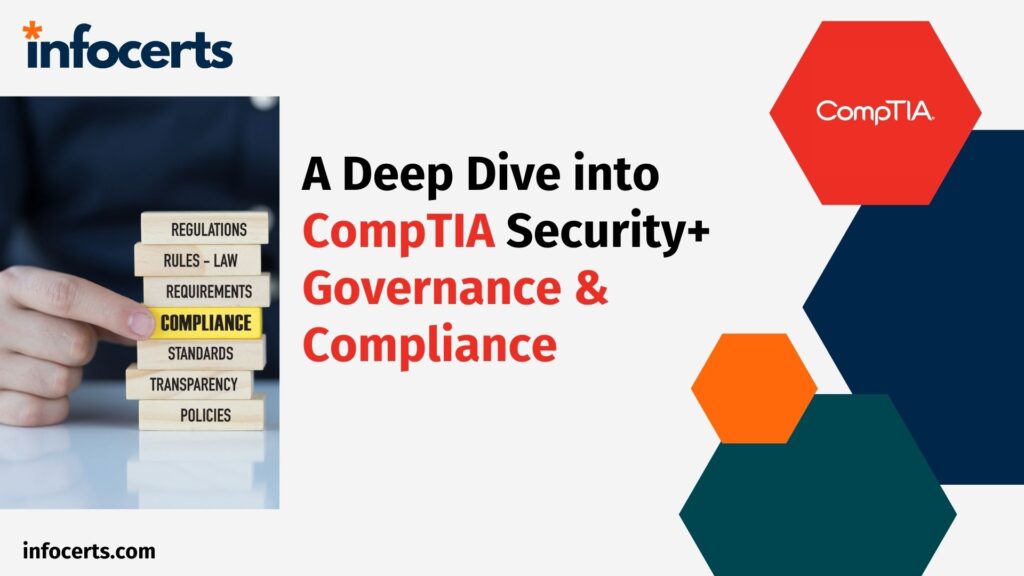January 30, 2024
Introduction
In the ever-evolving landscape of cybersecurity, understanding the principles of governance and compliance is crucial. The CompTIA Security+ certification, a globally recognized standard for IT security knowledge and skills, provides a comprehensive overview of these principles. This article delves into various domains of the CompTIA Security+ syllabus, focusing on governance, compliance, and the mitigation of security threats.

Domain 1.0: General Security Concepts
1.3 Change Management in Security Operations
Change management is pivotal in maintaining and enhancing security postures. It encompasses various business processes that impact security operations, including:
– Approval Processes and Ownership: Ensuring that changes are authorized and owned by responsible stakeholders.
– Impact Analysis and Test Results: Evaluating how changes might affect existing systems and validating them through testing.
– Backout Plans and Maintenance Windows: Preparing for reversals in case of unsuccessful changes and scheduling changes to minimize operational disruptions.
– Standard Operating Procedures (SOPs): Establishing consistent procedures for implementing changes.
On the technical side, this involves managing allow lists/deny lists, minimizing downtime, and addressing dependencies, especially in legacy applications. Documentation updates, like network diagrams and policies, alongside version control, are essential for tracking changes and maintaining system integrity.
Domain 2.0: Threats, Vulnerabilities, and Mitigations
2.5 Mitigation Techniques for Enterprise Security
A key strategy here is the principle of ‘Least Privilege’, which ensures that individuals have only the access necessary to perform their duties, significantly reducing the risk of unauthorized access or insider threats.
Domain 5.0: Security Program Management and Oversight
5.1 Elements of Effective Security Governance
Effective security governance involves a mix of guidelines, policies, standards, and procedures. This includes:
– Policy Development: Crafting policies like the Acceptable Use Policy (AUP) and policies on business continuity, disaster recovery, and change management.
– Standards Setting: Establishing standards for password policies, access control, physical security, and encryption.
– Procedure Formulation: Developing procedures for change management, onboarding/offboarding, and creating playbooks.
– Governance Structures: Understanding different governance structures, such as boards and committees, and their roles in centralized or decentralized entities.
5.3 Third-party Risk Assessment and Management
This involves rigorous processes like vendor assessment through penetration testing and audits, due diligence in vendor selection, and managing agreements (SLAs, MOAs, MOUs, MSAs). Monitoring and regular questionnaires are part of ongoing vendor oversight.
5.4 Elements of Effective Security Compliance
Compliance is monitored through internal and external reporting, and non-compliance can lead to fines, sanctions, or reputational damage. Organizations must conduct due diligence to ensure ongoing compliance, aided by automation tools.
5.6 Security Awareness Practices
Training in recognizing phishing attempts, understanding anomalous behavior, and conducting user guidance programs on various security aspects are crucial. Reporting mechanisms for suspicious activities must be clear and accessible.
Conclusion
CompTIA Security+ offers a robust framework for understanding the complexities of security governance and compliance. By mastering these concepts, professionals can ensure robust security strategies, compliant with legal and industry standards, while effectively managing risks associated with internal and external threats. This comprehensive approach is vital for maintaining the integrity and resilience of modern information systems.
To know more visit infocerts.com
FaQs:
- What is the significance of change management in security operations?
- How does the ‘Least Privilege’ principle contribute to enterprise security?
- What elements are involved in effective security governance?
- What are the consequences of non-compliance in security programs?
- How does security awareness contribute to an effective security program?
——————————————————————————————————————–
Infocerts, 5B 306 Riverside Greens, Panvel, Raigad 410206 Maharashtra, India
Contact us – https://www.infocerts.com

